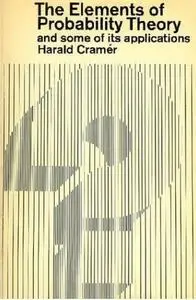Elements of Probability Theory and Some of It's Applications by Harold Cramer
Language: English | 1973 | ISBN: 0882751441 | 282 pages | PDF (scan) | 8,8 MB
Language: English | 1973 | ISBN: 0882751441 | 282 pages | PDF (scan) | 8,8 MB
A classic description of probability theory, which remains the proven work in the field.
This book is a revised and extended translation of a Swedish textbook which was published first in 1926 and then in entirely rewritten form in 1949. Starting with a historical introduction to the subjcct, the book covers the elements of the mathematical theory of probability, with the main emphasis on the theory of random variables and probability distributions. Applications to various fields, particularly to modern statistical methods, arc discusscd and illustrated by a number of examples. The problems offered for the reader's solution include simple exercises as well as important complements to the theories and methods given in the text.
The book is essentially an elementary treatise, and does not aim at a complete and rigorous mathematical development of the subjcct from an axiomatic point of view. In this respect it can only serve as an introduction to more advanced treatises, such as Fki.lf.r's Probability Theory, or the present author's Random Variables and Probability Distributions and Mathematical Methods of Statistics. Occasionally, for the complete proof of some theorem, reference will be made to one of the two last-mentioned works, which will be briefly quoted as Random Variables and Mathematical Methods.
As for the applications of mathematical probability, any book of modcrate size must be content with offering a small sample of problems and methods from the immense field of existing applications, which is continually expanding. Any selection of such a sample by an individual author will necessarily be influenced by a strong personal bias, and most certainly this rule will be found to apply here. Although Part III has been named "Applications", a number of important applications will also be found among the examples and problems that illustrate the theoretical developments in Parts I and II.
It will be assumed that the reader has some working knowledge of analytic geometry, calculus, and algebra, including determinants. Probably the book could be read without difficulty by a student at the junior level in an average American college. Some parts are, of course, more elementary than the others: in particular the first part, which could no doubt be read at an even earlier stage.



